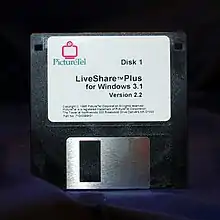PictureTel Corp.
PictureTel Corporation, often shortened to PictureTel Corp., was one of the first commercial videoconferencing product companies. It achieved peak revenues of over $490 million in 1996 and 1997 and was eventually acquired by Polycom [1] in October 2001.
 | |
| Type | Public |
|---|---|
| Industry | Telepresence & Videotelephony |
| Founded | August 1984 |
| Founders |
|
| Defunct | October 2001 |
| Headquarters | Danvers, Massachusetts, United States |
| Products |
|
History
PictureTel was founded in August 1984 as PicTel by MIT students Brian L Hinman, Jeffrey G. Bernstein and MIT Professor David H. Staelin.

The team was also assisted initially by MIT Professor Michael Dertouzos and two of his grad students Greg Papadopoulos and Richard Soley.
While at MIT Hinman and Bernstein were motivated by the video compression work by UC Davis Professor Anil K. Jain (1946–1988) and his colleague Jaswani R. Jain who published an important research paper[2] combining block-based motion compensation and transform coding in December 1981. The result was PictureTel, creating one of the first real-time systems[3] to implement motion compensation and transform coding in July 1986.
PictureTel was funded as "PicTel" by an initial public offering in November 1984, becoming a public company on virtually its first day of business. Product development started at this point. Its name was changed to PictureTel in 1987,[4] due to concern about potential name conflict with another communications company, Pacific Telephone Co., also known as PacTel. While the company demonstrated its first product in 1986, the company did not have meaningful product sales until 1987.
PictureTel's first product, the C-2000 codec (compressor/decompressor) was the first commercial implementation of this computationally intensive technology. By analyzing the motion between successive frames rather than treating the frames as a sequence of unrelated images, this algorithm was significantly more data-efficient (required the transmission of much less data) than existing techniques. Requiring less data also meant that it was compatible with emerging dial-up data networks such as ISDN, making its use less expensive and more flexible than the leased, fixed-location lines normally used for high-speed data transmission at the time.
Subsequently, most of the video compression standards for two-way communications and video broadcast applications have been based upon motion compensation and transform coding, including those most widely used today such as H.264/MPEG-4 AVC. PictureTel played a strong role in developing the industry standards for video, audio, and data communications, and released much of its technology for use free of charge.
In October 2001, PictureTel was purchased by Polycom, a company that was co-founded in 1990 by Brian Hinman and another early PictureTel employee, Jeffrey Rodman. Hinman and Bernstein would later be instrumental in creating 2Wire.[5]
See also
References
- Polycom To Acquire PictureTel Corporation. May 2001 Archived 2010-12-04 at the Wayback Machine
- Displacement Measurement and Its Application in Interframe Image Coding, December 1981
- History of PictureTel Corp. – FundingUniverse
- https://www.sec.gov/Archives/edgar/data/755095/0000950135-96-001824.txt
- E. Tahmincioglu, Friends Don't Always Make Good Partners, New York Times, Sept. 7, 2006.
Bibliography
- Smith, Tom (May 14, 1990). PictureTel Codec Software to Improve Video, Audio. Network World. 7. IDG Network World Inc. p. 26.
- Margolis, Nell (December 17, 1990). PictureTel Prospers in Tough Times. Computerworld. 24. IDG Enterprise. p. 73.
- Brown, Bob (October 19, 1992). PictureTel Sets Sights on Desktop Market. Network World. 9. IDG Network World Inc. p. 29.
- Wexler, Joanie M. (May 17, 1993). PictureTel Makes Videoconferencing Cheaper. Computerworld. 27. IDG Enterprise. p. 58.
- Chen, Steven C.M. (June 14, 1994). PictureTel Corp. - PictureTel Live PCS 100. PC Magazine. 13. Ziff Davis, Inc. p. 251.
- Messmer, Ellen (January 23, 1995). PictureTel to Unveil Group Share Data Collaboration Software. Network World. 12. IDG Network World Inc. p. 4.
- Cope, James (September 25, 2000). Caterpillar to Launch Satellite Videoconferencing System. Computerworld. 34. IDG Enterprise. p. 88.
External links
- MIT & PictureTel
- CNET
- PictureTel 900 Series
- Root, Timothy D. (January 2000). "Audio Communications Product Strategy for the 21st Century" (PDF). DSpace@MIT. Massachusetts Institute of Technology.
- IT World Staff (April 16, 2001). "PictureTel Slims Down Videoconferencing Device". IDG Communications, Inc.
- 1993 PictureTel Promotion on YouTube
- 1995 PictureTel New York Product Launch on YouTube